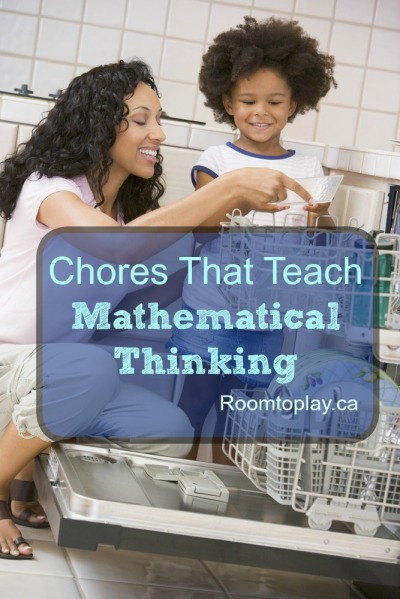- filed under: Family Life
Chores That Teach Mathematical Thinking
We all know it can sometimes be easier and faster to just do it ourselves. But did you know that by teaching your child a few household chores you are not only reducing the workload you have to tackle at the end of the day, but are also providing your child with valuable Mathematical skills? This post contains affiliate links for your convenience.
Chores that teach sorting.
Sorting is a pre-numeracy skill that lays the foundation for later mathematical fluency. Sorting teaches children to classify objects by “attributes” (size, colour, shape etc.) The ability to create sets and understand the rules of classification helps children learn to observe, compare and contrast. Try these tasks to explicitly teach early numeracy skills:
- Laundry: matching socks, making piles of what belongs to who and sorting clothing by colour. (lights, darks, whites) Read more tips for laundry lessons here.
- Unloading the dishwasher: teach that cutlery is put away into the correct slots and learn to sort dishes by attribute. (different sizes of plates and bowls, sorting plastic from pottery)
- Toy clean up: blocks in their bin, books on their shelf and markers separate from pencil crayons.
- Unloading groceries: teach the difference between fridge, pantry and freezer items. Sort them in bags at the grocery store and have your kids help with putting them away.
Chores that teach numeracy:
Young children can begin to work on early numeracy skills through your daily life as well. Numeracy is a broad term used to describe the ability to understand and use numbers meaningfully. While you are going about your day, don’t forget to point out to your child the mathematical process you are working through.
- Estimation: while out shopping ask, how much time will it take to walk to the store? How much will this cost with tax? A reasonable guess with a valid strategy is important for learning to estimate with accuracy. Thinking out loud models this skill for kids.
- Measurement: cooking with fractions, measuring elapsed time (how long did that take), ordering objects by attributes using superlatives (ie: tall, taller, tallest) or ordinal numbers (first, second, third).
- Money: teach the value of coins and bills as well as how to add, subtract and budget using decimals.
- Number concepts: children as young as three can be taught counting and representing numbers ie: We need four plates at the table because we have four people eating at the table tonight. The skill of matching a quantity to a value is called one to one correspondence and can take some time to master. Practice it whenever possible. The quantity of four is the same whether the child counts plates or cups or napkins. It is important for children to see that number can be represented in many ways.
- Comparing: teach the relative terms of more than and less than ie: who has more carrots on their plate, who has less milk in their cup.
With most children, there is an inverse relationship between their interest in helping and their ability to do the job! So encourage early interest and effort with comments like, “I can see how hard you are working to find the matching sock”. Specific attention to the effort a child makes, rather than the accomplishment itself, encourages further effort and makes them less likely to give up when a task gets hard in the future.

See more curated ideas for organizing your family life on my Pinterest pages:
